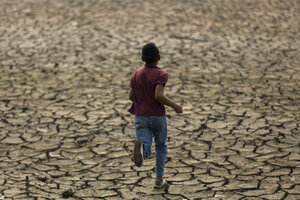Is Brazil nearly out of fresh water?
As the drought in Southeastern Brazil drags on, the people of Sao Paulo are struggling with stringent rationing. What accounts for the water crisis and how could it be remedied?

A boy runs at the bottom of a branch of the Lago Seco, that receive water from the Amazon river, in the city of Manaus, Brazil, October 26, 2015. A severe drought has pushed river levels in Brazil's Amazon region to lows, leaving isolated communities dependent on emergency aid and thousands of boats stranded on parched riverbeds.
Bruno Kelly
Once considered “the Saudi Arabia of Water,” Brazil is now nearly deplete of it.
As drought continues to scorch Southeastern Brazil to unprecedented degrees, Sao Paulo primary water reservoir, the Cantareira, has been reduced to its last drops. As of August, it is 17 percent of capacity.
As for the residents of Sao Paulo, NPR’s Lourdes Garcia-Navarro and Lauren Migaki report, conservation groups predict there may only be enough water to last five more months.
Last month, NASA’s new satellite data revealed that the drought is much worse than originally believed. The Southeast has lost 56 trillion liters of water every year for the past three years, the report found – a figure that those releasing the data hope will serve as a wakeup call to local policymakers.
But drought isn’t the only factor behind the severe shortage.
Recent studies show that deforestation has significantly exacerbated the lack of rain. The Amazon region’s hair-poofing humidity is the result of the rainforest vegetation. Trees not only remove carbon dioxide from the atmosphere but also release vast amounts of water vapor, creating "flying rivers" that subsequently fall as rain.
These flying rivers, scientists say, carry more water than the Amazon River itself. But every year, the forest diminishes by thousands of square miles, impeding the livelihood of such airborne streams and curtailing precipitation.
Some studies even suggest the impact of deforestation on drought can carry as far as California and Texas.
“There’s lots of evidence that changing the water cycle in the Amazon would have global consequences,” David Schimel, an eco-climatologist at NASA’s Jet Propulsion Laboratory, told The New York Times. “It’s a fairly robust notion.”
Back in Brazil, most indicative of the dire situation is the vacation resort built on the banks of the Cantareira. Once a haven for the people of Sao Paulo, it’s now completely dead – as empty as a ghost town, the NPR reporters note. Even the lake on the grounds has dried up.
But one fewer vacation spot is the least of problems for Brazil’s most populous city. After two years of record-breaking drought, residents have learned to be extra resourceful. Dishes and laundry, for instance, will have to come after showers and flushing.
Conditions have grown so difficult that many have moved out of the city. Restaurant owner Cesar Farinha Figueredo was among the “water refugees” who migrated to cities with better irrigation and conservation plans.
He told NPR that the people who can afford to move out of Sao Paulo will eventually do.
But Sao Paulo, as well as the also water-starved Rio de Janeiro, is not forever doomed. The water crisis can be at least partially attributed to poor city planning.
Some say the water infrastructure has long been in need of an upgrade. Pipes, dams, and transmission lines are often faulty. A government report has even found that nearly 40 percent of tap water is wasted due to leaky pipes, fraud, and illegal access.
While higher standards and more thorough preparation could have prevented the crisis, human error points to the possibility of human remedies.
Experts suggest a two-prolonged effort of balancing developmental projects that account for frequent drought with environmental objectives, including salvaging the Amazon and recognizing climate change.
In the city of Jundiai, where Mr. Figueredo now lives, water is no issue because of shrewd local government policies that prioritize conservation and careful management.
Nearly 1 billion people around the globe don’t have access to clean drinking water. But, as scientists foresee, certain regionally specific policy and best practices can alleviate the crisis.

